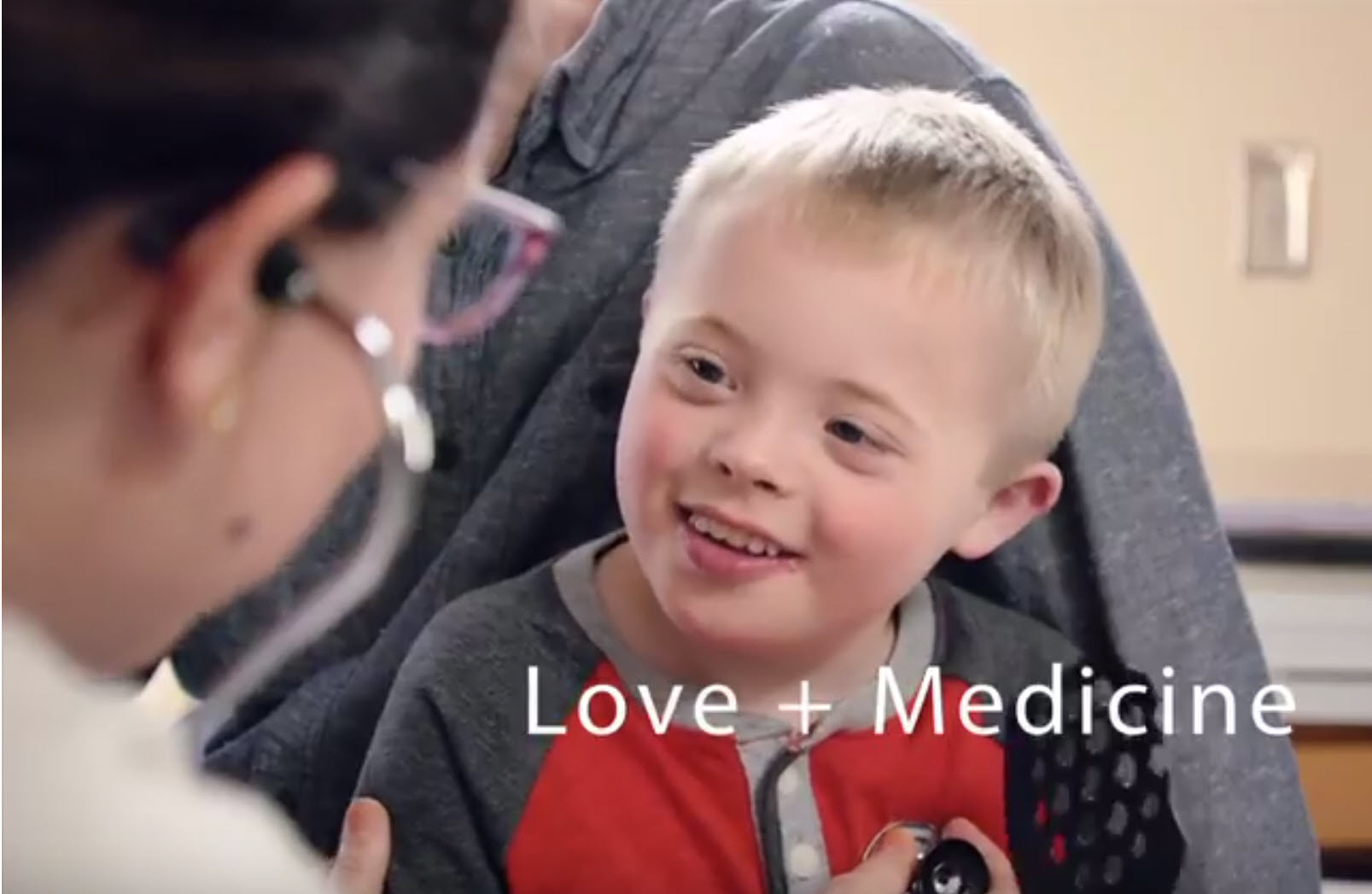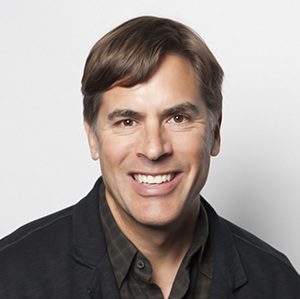Getting Emotional — In an Understated Way — Helps a Hospital with a Good, Strong Reputation Stand Up to Another Hospital with a Good, Strong Reputation
Notable Health Care Advertising
// By Peter Hochstein //
 Meet Tanner, the star of a TV spot. He’s a cute but very wary little boy with Down syndrome. He clings possessively to an old and partly broken kitchen spatula. Tanner and his beloved spatula are paying a visit to a doctor’s office.
Meet Tanner, the star of a TV spot. He’s a cute but very wary little boy with Down syndrome. He clings possessively to an old and partly broken kitchen spatula. Tanner and his beloved spatula are paying a visit to a doctor’s office.
Tanner is reticent. The doctor, a friendly woman, pretends to examine the spatula. Tanner resists this at first, but gradually warms to the game. He helps measure the spatula’s height. Then he helps the doctor out by measuring his own height. When the doctor “listens” to the spatula with her stethoscope, she piques Tanner’s interest again.
 Next, the doctor uses the stethoscope to listen to Tanner’s heart. Finally, Tanner looks up at the doctor and for the first time, he smiles. Across the screen come supers that display the slogan “Love + Medicine” and the logotype of the La Crosse, Wisconsin-based Gundersen Health System.
Next, the doctor uses the stethoscope to listen to Tanner’s heart. Finally, Tanner looks up at the doctor and for the first time, he smiles. Across the screen come supers that display the slogan “Love + Medicine” and the logotype of the La Crosse, Wisconsin-based Gundersen Health System.
Unlike much hospital TV advertising that is emotional because it involves some life-or-death situation, a series of TV spots for Gundersen achieve their emotional impact through modest understatement.
It’s almost impossible to watch this spot without feeling an emotional twinge, as the doctor wins Tanner’s trust, and cooperation.
Little stories that end with an emotional twist are a common element in this currently running advertising campaign for Gundersen, a system with 425 licensed beds and more than a million total clinical visits last year. Gundersen is also a teaching hospital, and according to its website, “Repeatedly named among the top 50 hospitals in the nation, placing us among the top one percent.”
So why isn’t that impressive credential front-and-center in the advertising? Look who the main competition is — Mayo Clinic, which ranks as number one according to U.S. News — and you’ll have the answer. Well, at least part of the answer.

Pamela Maas, chief business development and marketing officer at Gundersen Health System
Pamela Maas, Gundersen’s chief business development and marketing officer, who never mentioned Mayo by name during an interview, says the impetus for the current campaign came when “our lead competitor in the market,” a “globally recognized brand,” began doing testimonial advertising, which happens to have been what Gundersen also was doing at the time.
Consequently, she says, “We started looking at how health care in general was being positioned. It seemed like so many systems in health care were looking and feeling exactly the same. We recognized that brand positioning was really about building an emotional connection with consumers.” So, she says, a decision was made to “move away from telling what we do to telling why we do it.”
With that came a shift to a campaign that dispensed with testimonials in favor of story-telling vignettes. In another touching spot, we see Sam, a heart patient, pedaling through a city on his way to work. He arrives at the office and hangs up his bike helmet on a hook, day after day, until one day, there’s a second bike helmet on the rack, bringing a smile to Sam’s face.

Chris Preston, executive vice president and creative director, Preston Kelly
Chris Preston, executive vice president and creative director of Gundersen’s Minneapolis ad agency Preston Kelly, recalls that his agency began reading fan letters and emails from patients. He found story after story about people who had been touched by Gundersen staff members who, in one way or another, had gone above and beyond their job descriptions to help.
“We realized it was kind of like the Nordstrom Legends,” Preston says, referring to the department store chain’s reputation for performing extraordinary acts of customer service. “We kind of decided that caring was really a demonstration of humanity. We called it love.” That in turn evolved into the Love + Medicine slogan.
The campaign, launched in 2015, focuses on “these moments of compassion and care that sort of transcended the scientific medical experience when you decided who you would put your family’s trust with,” Preston says. All the spots are based on true stories, he adds.

Kendra Maggert, business development and marketing manager at Gundersen Health System
Kendra Maggert, Gundersen’s business development and marketing manager, likens what sets her campaign apart to the advertising that separates Subaru from Ford. In some of its advertising, Ford talked about its high consumer satisfaction ratings awarded by JD Power and Associates. Meanwhile, Subaru told a story about a child who gets driven around in the family car, grows up, and finally drives the same car himself.
If the emotional twists in Gundersen advertising are surprising, the target market is a familiar one. Gundersen has even given her a persona.
“We called her Marie,” says Maggert. “We gave her a name to make sure we’re always homing in on who she is.”
Experienced hospital marketers will recognize her profile: a woman, 25 to 54, who’s the primary family health care decision-maker, “motivated by cost, care expertise, and convenience.”
Gundersen is reaching “Marie” largely by broadcast TV, radio, and some print and outdoor advertising. And the advertising is having an impact. A 2016 consumer perception study based on 443 telephone surveys and 227 online surveys among patients and non-patients in five areas that Gundersen serves reports that Love + Medicine outperformed Mayo and another local hospital brand “even though L+M was just launched in March 2015, whereas other system branding has existed for multiple years,” Maggert reports.
Moreover, she adds, “there are net positive shifts in opinions of Gundersen over the past year.”
Now that’s something else for hospital marketers to get emotional about.
Notable Suggestions
- Look beyond your bubble. “I think it’s beneficial to look outside of the health care industry and see what others are doing,” says Maggert. “At the end of the day, we’re all marketing to consumers. And really, our patients are They just happen to be consumers of health care.”
- Let marketers be the marketers. When they first saw the campaign, some Gundersen doctors were concerned about the use of the word “love,” insisting that love is “something you have with your family and your spouse,” says Preston. But “after seeing the campaign running and the response they’re getting, they came back and said, ‘No, you guys were right.’” People involved in approving a campaign are smart, but “they’re not always good marketers. Step back, doctors, and hospital administrators, and P&L-responsible people,” adds Preston, “and let the marketers do their job.”
Peter Hochstein is a direct-response advertising consultant, business journalist, and author. He is the author of Lessons from 9 Innovative Health Care Marketing Campaigns. You can reach him through his website: http://peterhochstein.com.
